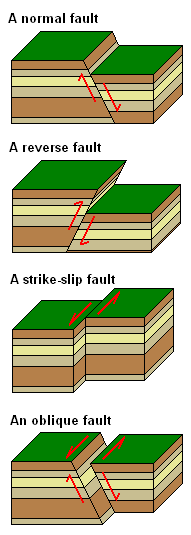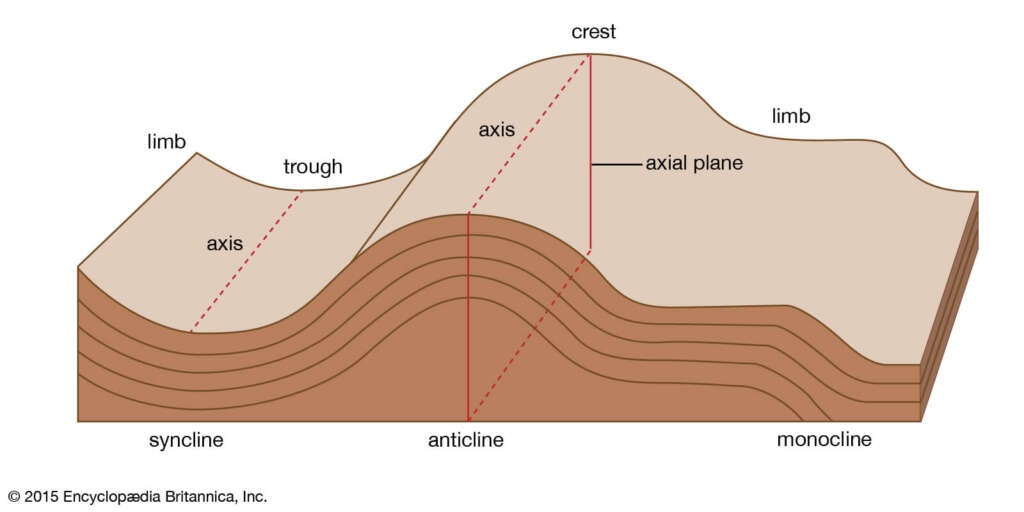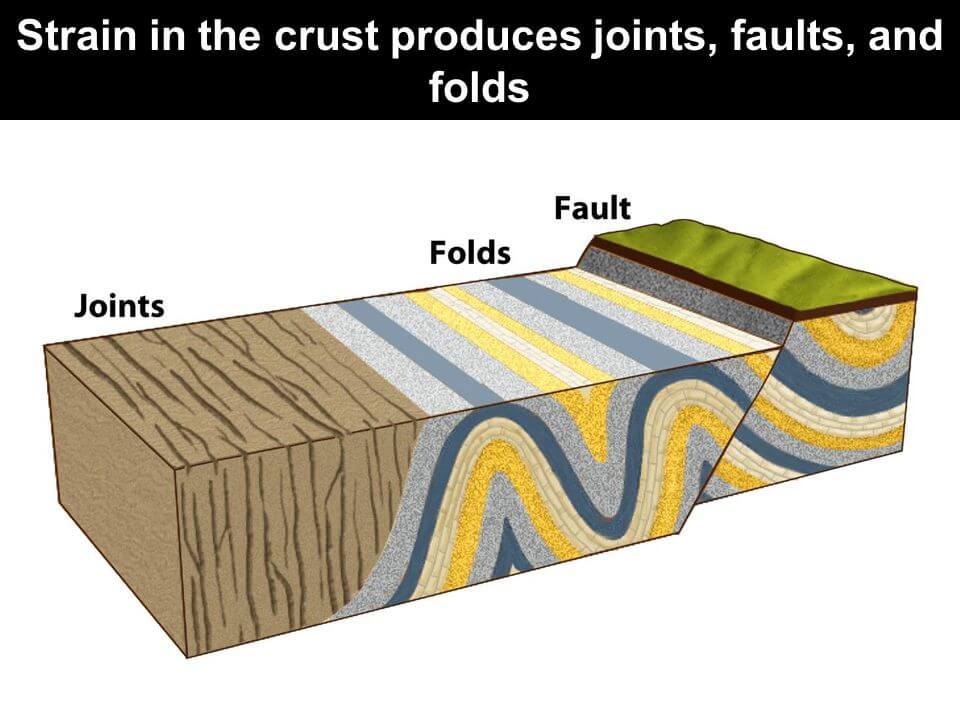Structural geology is concerned with the description, spatial representation, and analysis of structural features ranging from microscopic to megascopic. It controls the migration of groundwater, oil, gas, and natural minerals.
Fault
Faults are the fractures in bedrock along which movement has occurred. They are categorized by type of movement as dip-slip, strike-slip, or oblique-slip fault.
Types of Fault
- Dip-slip faults: They have movement parallel to the dip of the fault plane. In normal faults, the hanging-wall block has moved down relative to the footwall block. In reverse faults, the hanging-wall block has moved up relative to the footwall block.
- Strike-slip faults: They have a movement that is predominantly horizontal and parallel to the strike of the fault plane. A viewer looking across to the other side of a right-lateral strike-slip fault would observe it to be offset to their right. A viewer looking across to the other side of a left-lateral strike-slip fault would observe it to be offset to their left.
- Oblique-slip faults: They have movement with both vertical and horizontal components.

How to recognize faults in the field
- Discontinuity of structures
- Repetition or omission of strata
- Silicification and mineralization
- Feature characteristics of the fault plane
- Sudden changes in sedimentary facies
- Physiographic evidence
Significance of faults on landscape/outcrop formation
- Destruction of earth surface through earthquake
- Lowers the stability of land
- May play role in origin of earthquake and volcanism
- May results thermal spring in particular area due to friction
- Play role in soil formation through silicification and weathering
Folds
Folds are a wavelike bends in layered rock. They represent rock strained in a ductile manner, usually under compression.
The axial plane divides a fold into its two limbs. The surface trace of an axial plane is called the hinge line(or axis) of the fold.
Parts of folds

- Hinge (axis): Axis is the maximum curvature in a folded bed.
- Axial plane: It is the surface connecting all the axis. It may be vertical, inclined, and horizontal.
- Limb: It is on either side of the fold.
- Crest: It is the highest part of the folded bed.
- Trough: It is the lowest part of the folded bed.
- Crest plane: It is the line that connects all crests.
- Trough plane: It is the line that connects all troughs.
Anticlines are upward-arching folds, and synclines are downward-arching folds. Anticlines eroded horizontally at the surface show the oldest ages in the centerline. Synclines eroded horizontally at the surface show the youngest ages in the centerline(bedding ages are symmetrically older going away from the center).
Here are some other types of folds:
- Plunging folds: They are folds in which hinge line is not horizontal, where surfaces have been levelled by erosion, plunging folds form V- or horseshoe-shaped patterns of exposed rock layers (beds).
- Open folds: They have limbs that dip gently, whereas isoclinal folds have parallel limbs.
- Overturned folds: They have limbs that dip in the same directions.
- Recumbent folds: They are overturned to the point of being horizontal.
Significance of folds on landscapes/outcrop Formation
- They cause shortening of the earth crust and their subsequent thickening
- Usually stream follows from the axis portion of the anticline ridges
- Dome structures occur along the axis of the syncline
- Repetition of beds in their occurrence infers the presence of fold
- May develop fractures and joints in anticline ridge and result soil formation through weathering and: lowers stability of land.
Joint

A joint is a break(fracture) of natural origin in the continuity of either a layer or body of rock that lacks any visible or measurable movement parallel to the surface(plane) of the fracture.
A joint set is a family of parallel, evenly spaced joints that can be identified through mapping and analysis of the orientations, spacing, and physical properties. A joint system consists of two or more interlocking joint sets.
Causes of Joints in Geological strata
- Joints results from brittle fracture of a rock body.
- As a result of tensile stresses
- The rise of pore fluid pressure as the result of either external compression or fluid injection
- The result of internal stresses induced by the shrinkage caused by the cooling.
Classification of Joints
Joints are classified on the following bases:
Genetic Classification:
- Tensional joint: This is a shrinkage joint
- Shear Joint: This joint is developed from the sliding history of geological strata
- Tectonic joint: Joints developed from tectonic activities and categorized according to attitude of beds.
Geometric classification
- Strike joint: Joints strike in the same direction of the rock formation
- Dip joint: Joint strike parallel to the dip of the rock formation.
- Oblique/diagonal joint: The strike of the joint makes an inclined angle with the strike of the rock formation.
Significance of Joints
- To understand the nature and sequence of deformation in an area.
- Joints commonly control the drainage pattern of the area.
- May act as aquifers or reservoirs in rocks for oil or natural gas or groundwater.
- Help to find out the brittle deformation in an area of construction (dams, bridges, road, building, and power plants).
- In mineral exploration, finding out the trend and type of fractures and joints that host mineralization that will help in the exploration.
- Joints play a great role in soil formation through chemical (decomposition), physical (disintegration), and biological weathering.
- It lowers the stability of the land.
Differences between faults, folds, and Joints
Here are some major differences between fault, fold and joints:
- The fold is permanent wavelike deformation in layered rock or sediment, fault is a fracture in bedrock along which rocks on one side have moved relative to the other side whereas a joint is a fracture on a rock without noticeable movement.
- Joints and faults are types of fractures. A joint is a fracture along which no movement has taken place, usually caused by tensional forces. A fault is a fracture or breaks in the rock along which movement has taken place. One might expect more earthquakes to occur near faults.
- The results of stress are folding and faulting. When a rock has stress put on it and does not break it is called folding. Folds appear as wave-like structures in rock layers. Some folds are small and can be seen in individual rocks and some folds are huge and can only be seen from the air.
- Folds typically occur in hotter rocks as this makes them more bendy/ ductile.


[…] + View Here […]